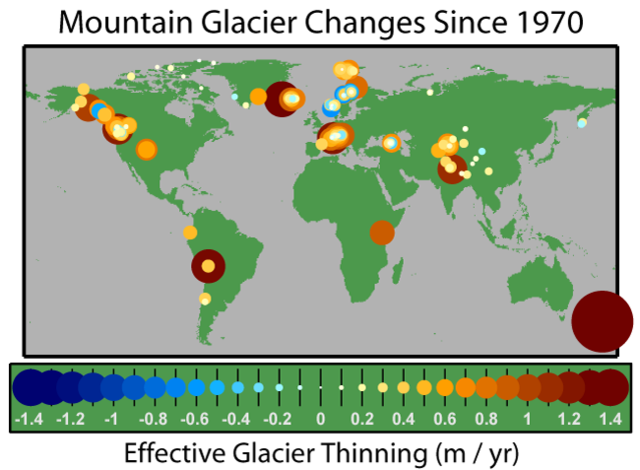Image:Glacier Mass Balance Map.png
From Wikipedia, the free encyclopedia

Size of this preview: 640 × 470 pixels
Full resolution (650 × 477 pixels, file size: 108 KB, MIME type: image/png)
Contents |
Summary
The effective rate of change in glacier thickness, also known as the glaciological mass balance, is a measure of the average change in a glacier's thickness after correcting for changes in density associated with the compaction of snow and conversion to ice. The map shows the average annual rate of thinning since 1970 for the 173 glaciers that have been measured at least 5 times between 1970 and 2004 (Dyurgerov and Meier 2005). Larger changes are plotted as larger circles and towards the back.
All survey regions except Scandinavia show a net thinning. This widespread glacier retreat is generally regarded as a sign of global warming.
During this period, 83% of surveyed glaciers showed thinning with an average loss across all glaciers of 0.31 m/yr. The most rapidly growing glacier in the sample is Engabreen glacier in Norway with a thickening of 0.64 m/yr. The most rapidly shrinking was Ivory glacier in New Zealand which was thinning at 2.4 m/yr. Ivory glacier had totally disintegrated by circa 1988 .
Copyright
This figure was originally prepared by Rober A. Rohde from published data and is incorporated into the Global Warming Art project.
| Image from Global Warming Art This image is an original work created for Global Warming Art. Permission is granted to copy, distribute and/or modify this image under either:
Please refer to the image description page on Global Warming Art for more information |
Notes
This sample of mountain glaciers excludes the primary ice sheets of Greenland and Antarctica.
It should be acknowledged that glacier sampling is heavily biased towards North America and Europe. Africa has only a handful of glaciers, whereas Australia has none. However substantial unsampled mountain glaciers do exist in South America, Asia and the margins of Antarctica. Despite their importance, none of the marginal Antarctic glaciers have had their mass balance sampled at least 5 times since 1970.
These estimates of ice sheet thinning do not include glacier mass lost due to iceberg calving. Such calving is not significant for most mountain glaciers, since only a small proportion of these glaciers terminate in the ocean.
Reference
- Dyurgerov, Mark B. and Mark F. Meier (2005). "Glaciers and the Changing Earth System: A 2004 Snapshot". Institute of Arctic and Alpine Research, Occasional Paper 58.
| |
This graph image was uploaded in a raster image format such as PNG, GIF, or JPEG. However, it contains information that could be stored more efficiently and/or accurately in the SVG format, as a vector graphic. If possible, please upload an SVG version of this image. After doing so, please replace all instances of the previous version throughout Wikipedia (noted under the “File links” header), tag the old version with {{ Vector version available|NewImage.svg}}, and remove this tag. For more information, see Wikipedia:Preparing images for upload. For assistance with converting to SVG, please see the Graphics Lab. |
 |
| |
This image or media file may be available on the Wikimedia Commons as Image:Glacier Mass Balance Map.png. The uploader requests that the local copy of this work not be deleted. |
|
File history
Click on a date/time to view the file as it appeared at that time.
| Date/Time | Dimensions | User | Comment | |
|---|---|---|---|---|
| current | 08:04, 4 March 2006 | 650×477 (108 KB) | Dragons flight ( Talk | contribs) | (Map of glacier mass balance changes) |
See the setup instructions for more information.
File links
The following file is a duplicate of this file: